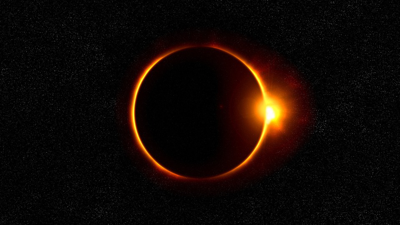Eclipse watchers are keeping a close eye on the weather ahead of a solar eclipse that will plunge a wide strip of North America into daytime darkness on Monday.
Forecasters are predicting cloudy conditions in northern Mexico, Texas and parts of the Great Lakes region.
Better weather is expected in western Mexico and parts of the US Midwest.
And some of the best viewing is likely to be under clear spring skies in New England and Canada.
Starting in the Pacific Ocean, the eclipse will become visible on the coast of Mexico near the city of Mazatlan at about 11:07 local time (19:07 BST).
The shadow of the Moon will run across the Earth at a speed of 1,500 mph (2,400 km/h) – tracing a north-easterly arc through the states of Durango and Coahuila before casting parts of Texas, Arkansas and neighbouring states into darkness.
As the path crosses over the US Midwest, a phenomenon known as totality – when the Sun is completely obscured by the Moon – will cross over the cities of Indianapolis, Cleveland and Buffalo.
At around 15:18 Eastern (19:18 GMT) the eclipse will reach Niagara Falls, where a record crowd of up to a million people is expected to turn out to watch mist from the famous cataract turn a pinkish hue – provided the weather co-operates.
The shadow will continue to travel north east through the New England states and into Canada’s Maritime provinces before tracking into the Atlantic Ocean and ending at 20:55 BST.
The eclipse is the first this century to cross over all three North American countries.
Here is a breakdown of when totality will occur in US and Canadian cities, all in local time:
San Antonio, Texas: 13:33 Central (19:33 BST)
Dallas, Texas: 13:40 Central
Carbondale, Illinois: 13:59 Central
Cleveland, Ohio: 15:13 Eastern
Buffalo, New York: 15:18 Eastern
Burlington, Vermont: 15:26 Eastern
Montreal, Quebec: 15:27 Eastern
Fredricton, New Brunswick: 16:33 Atlantic
Gander, Newfoundland and Labrador: 17:12 Newfoundland time
Special events, festivals and even mass weddings will take place in towns and cities across the path.
Nasa and its partner organisations are hosting more than 100 events, including gatherings where the eclipse will first be visible from land in Mazatlan, at the Cotton Bowl stadium in Dallas and at Indianapolis Motor Speedway in Indiana.
Crowds will fill a football stadium in Carbondale, Illinois, where the path of Monday’s eclipse will intersect the path of the last solar eclipse to travel across the United States, in 2017.
The main variable for many viewers will be the weather down here on Earth.
In its latest eclipse forecast Sunday, the US National Weather Service warned of potential severe conditions including heavy rain, tornados and hail which may affect travel in Texas and nearby states. The view in San Antonio is expected to be almost entirely obscured by clouds.
However, cloudy conditions will not necessarily spoil the experience. No matter the weather, the sky will still dim considerably as the Moon’s shadow travels across the Earth.
The Sun will be partially obscured even thousands of miles away from totality, but the most dramatic events will be experienced by those in the direct path. Some locations will experience totality for nearly four and a half minutes.
The Moon will completely cover the Sun, with only the corona – the star’s bright outer atmosphere – visible. The temperature will fall and wind patterns and cloud formations could shift. Some animals will be tricked into thinking day has turned to night, and stars and planets might be visible in the sky.
Scientists will take advantage of the eclipse to perform experiments, launch rockets into the sky, observe animal behaviour and study the corona.

